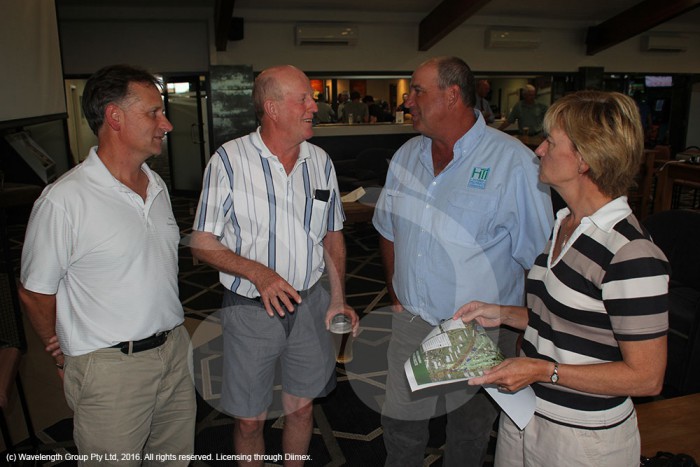Smart Design Around Bypass
THE mood was positive at last night’s meeting at the Scone Sporties to discuss the designs of the Scone golf course.
More than 40 people attended the meeting to learn what their golf course would be like after the bypass.
World renowned golf course architect Harley Kruse and Hugh Leicester director of Shape On It presented their designs and answered questions from the community.
The key constraint for the new golf course is that the Roads and Maritime Authority (RMS) have a policy that the golf course may not be better as a result of the bypass, commonly referred to as the ‘betterment clause’.
However, the golf course needs to be consistent with current industry standards, especially safety standards.
The smart designs of the golf course architect and developers seem to have overcome the challenges the bypass presents.

Discussing the Scone golf course design: Harley Kruse, golf course architect, Ross Banks, Scone golfer, Hugh Leicester, director of Shape On It and Lynette Banks, Scone golfer.
Harley Kruse, golf course architect, said the project was an exciting one that could attract golf tourists to the area.
“I want to see the Scone golf course as a well known country par 72 golf course that is worth travelling to play on,” said Mr Kruse.
“We want it to be a fun and exciting course and challenging for golfers, but attract people who come through to have a round of golf,” he said.
“It is designed for all levels of golfer, especially the juniors of Scone,” he said.
“We want more people in town to take up the game and it could have a changing impact on the town if they welcome the golf community people will travel up and tick the course off their golfing list.
“In the lower Hunter the Vintage combines wineries and golf, Scone can combine horses and golf,” Harley Kruse said.
In terms of developing around the impacts of the bypass Harley Kruse said it was relatively straight forward.
“I’ve designed a golf course in the mountains of Korea, so this is relatively straight forward,” he said.
“The bypass presents a visual amenity issue, with semi-trailers and noise, but our intent is to landscape and restore woodland to the edge, but keep some windows so that travellers can see the course.
“We’ve been able to keep all of the big beautiful trees and they are great to keep,” he said.
“A lot has changed since the course was built in the 1940’s, especially with the safety aspect of design,” Harley Kruse said.
The main concerns raised by local golfers included:
- no practice fairway;
- flood mitigation measures;
- retention of existing bridges;
- the sustainability and ongoing upkeep of the course and
- the 190 metre par 3’s.
To ensure 9 holes will stay in play during the construction of the bypass, 4 holes will be established before work on the bypass begins and work on those holes will need to begin in April.
One bridge will need to be replaced with a bridge to accommodate ambulance access and the car park will be confined to one side of the club house to improve safety and allow players to walk out straight onto the golf course.
All feedback will be taken into consideration in the final design and must be lodged with Council by Friday, February 12.
The designs will then go before Council on February 22 and progressed with the RMS.
 scone.com.au
scone.com.au